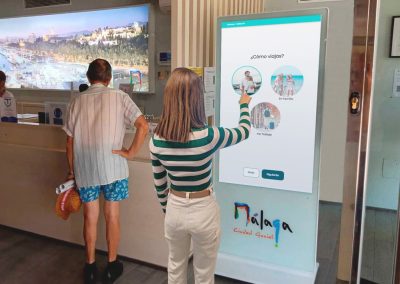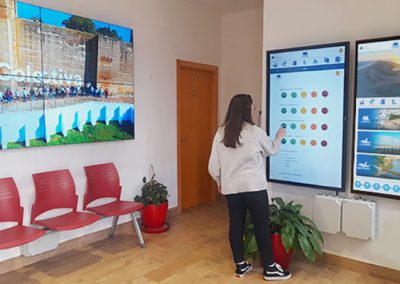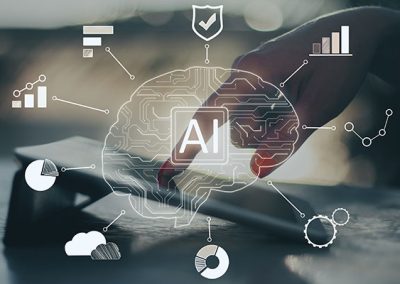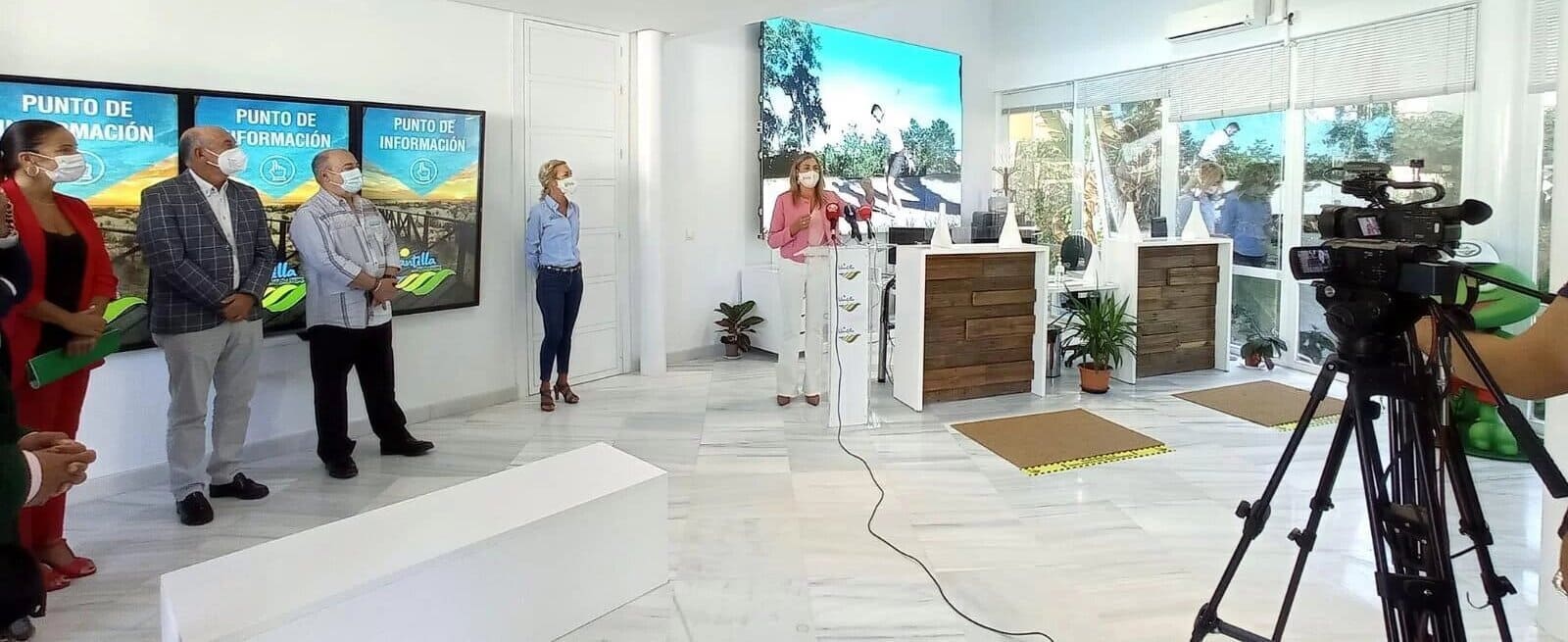
5 Fully digital tourist information centres
The Spanish government has allocated €1,788,600,000 in 2023 for the “Regional Plans for Sustainable Tourism for Destinations” initiative, which saw an investment of €719 million for tourism sustainability projects in 2022, 18.5% more than the €650 million in 2021. The digitalisation of tourism is the priority objective of Component 14 of the Resilience Plan. A few of the reasons behind this focus on digitisation:
. To get a better understanding of the tourists who visit us to build their loyalty.
. To provide service to visitors before, during and after their arrival, through any medium.
. To streamline citizen services through new digital channels that serve as tools to help tourist centre advisers to create high-value tourist attractiions based on this knowledge.
. Improve tourism sustainability to save costs and protect the environment.
Digital tourist information centres are much more than just the first point of contact for tourists visiting a destination: the work they do covers the entire traveller cycle, as indicated by SEGITTUR.
CHALLENGE 1: MANAGE THE CONNECTED TOURIST AT EVERY STAGE OF THE TRAVEL CYCLE
“Destinations need to capture visitors, monetise their stay and capitalise on tourist satisfaction by encouraging repeat visits and recommendations. Smart destinations gain their competitive advantage by being able to improve the conditions in which this happens.” SEGITTUR
Bruno Goval from the Association of French Tourism Information Centres (FNOTSI) clearly defines the roles that a tourist information centre must play:
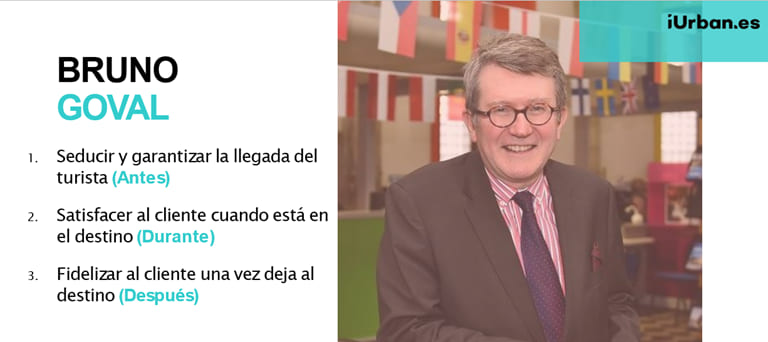
In this post we’re going to take a look at five success stories of tourist centres that have already achieved this goal, paving the way so that you can copy some of their strategies. But first, let’s learn a little more about the history and roles of tourist information centres.
History of tourist information centres
Ever since the first one opened in Barcelona in 1906 on the ground floor of the city hall building in Plaza Sant Jaume, tourist information centres in Spain have always served as the point of contact with the tourist at the destination, a space designed to enhance the tourist’s experience through interactions in their own language.
Etymology The words “oficina de turismo”, translated literally as “tourist office”, come from the Latin “officina” (workshop, factory), a contraction of “opificina”. It is composed of the root of “opus” (work) and the root of “facere” (to do), while the word “turismo” comes from the Latin “tornus” which means turn or movement. “Turismo” comes from the English tourism, which comes from the French “tornare”, or turn on a lathe. That’s why the purpose of an information centre isn’t just to serve the visitor, but also to work together with local agents to create experiences in the destination that will boost tourist satisfaction and turn them into repeat visitors.
Current role of tourist information centres
Reyes Maroto, Minister of Industry, Trade and Tourism, estimates that Spain will have received more than 71.5 million international tourists in 2022, 85.6% of the pre-pandemic level. In terms of cumulative spending, this is estimated by the Minister of Tourism to reach €87.1 billion, down 5.6% from the figure for 2019, when tourism accounted for 12.6% of GDP.
It is unbelievable that even though tourism pulls in these sums of money, tourism departments are always “the poorest department of the town councils” with dwindling resources, and yet some of the services that the information centres provide rank among the most advanced at a national level.

“Gestión Oficinas de turismo” (Tourism Information Centre Management) by Oriol Mirabell Izard
In this section we’re going to focus on tourist services, the main reason these centres are created, and undoubtedly a source of expertise when it comes to providing services to the local sector and for creating content and dedicating internal resources.
Let’s go! A tourist information centre is much more than just a physical space. It’s a communication channel with the tourist, and now that tourists are online, they no long phone or write asking for information, instead opting for social media and blogs to plan their trip. So if you want to attract them to your destination [spoiler alert] you need to be there at every stage of their trip, and to do that you need to be digital. Some examples:
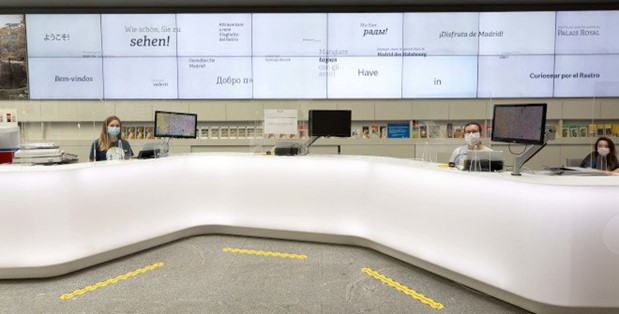
1. Madrid’s Plaza Mayor. Accessibility and self-service areas if there are queues
Madrid has one of the most modern tourist centres in the country in the Salón de Columnas de la Casa de la Panadería in the central Plaza Mayor. It is open 365 days a year.
Digitalisation
. It has laptops and self-service areas so that visitors can browse information if the counter is busy.
. The advisers are equipped with a monitor to display the points of interest on a map while explaining the itinerary, as well as software for registering tourists and centralising data and surveys.
. It has a large linear video wall with dynamic signage showcases different events and campaigns depending on the time of year.
. A robotic assistant named “Pichi” gives visitors information about the top things to do and see in their language.
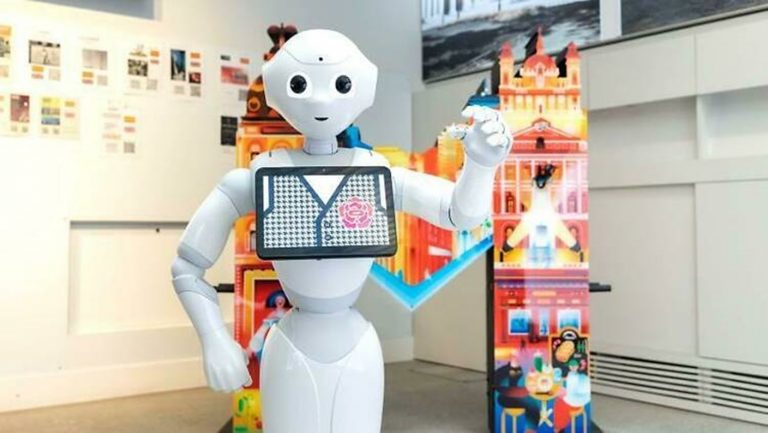
Accessibility
. Spanish Sign Language.
. Magnetic loops This is a system that offers a clean transmission from the source to the hearing aid, eliminating background noise and reverberations that hinder communication.
. Accessible Tourism Guide (on CD)
What’s missing:
. The monitors should show a static map, which would make it easier to map out the itinerary according to the type of tourist.
. The rear video wall should be personalised for each tourist but instead displays pre-programmed loops. They could take advantage of the fact that the monitors can be divided, providing access to each adviser and show videos about the attractions they’re explaining.
. Although the opening hours are quite long (Mon-Sun: 9:30 a.m. to 8:30 p.m.), they don’t provide service when the centre is closed, even though a basic tenet of digitalisation is to always be open.
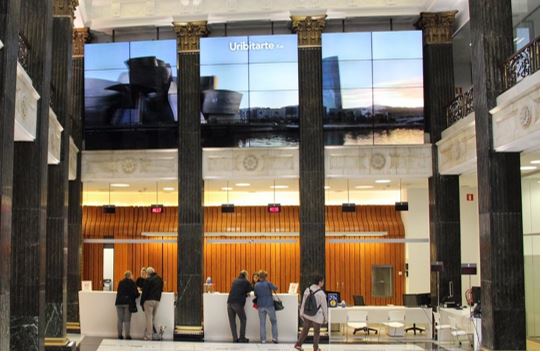
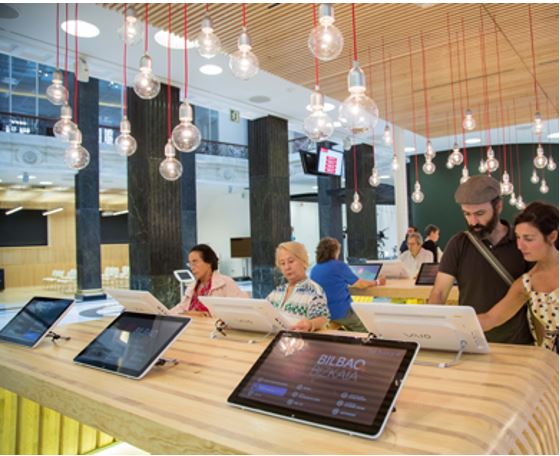
2. Bilbao. More than an information centre, a refuge for tourists
The Bilbao-Bizkaia Tourism Information Centre offers information on the capital and all the regions of Bizkaia. It is located in an iconic building in the city that is more than 120 years old (although with the renovation no one would ever say so).
With a surface area of 550 square metres and signage in five languages and Braille, it serves the public in six languages (Spanish, Basque, English, French, German and Italian), 365 days a year.
Digitalisation
. A wall with 24 screens suspended above the information desks allows for video and live streaming.
. Equipped with 18 computers (two of which are adapted for people with sensory disabilities) and three iPad stations.
. Tourist registration and survey software, and digital planner so that tourists can take the guide with them on their mobile phones, as well as digital brochures with interactive information.
. The office has six customer service points, two of which are adapted for people with reduced mobility.
What’s missing:
. Like in Madrid, the rear video wall isn’t personalised for each tourist. However, thanks to the DTI Biotip that is being implemented, the plan is to switch the monitors to LEDs for a mroe seamless video wall and a screen that can be fragmented in a much freer way.
. And just like Madrid, it’s lacking the ability to provide information when it’s closed, and it’s a well-equipped centre during the tourist’s visit in the destination, although the contact it has with tourists before the visit is similar to any other city (email and phone).

3. Islantilla (Huelva). Digitalisation at all stages of the travel experience and “wow” effects.
The Islantilla association of townships covers two municipalities, Lepe and Isla Cristina, and is a highly popular tourist destination that experiences a drop in tourism in the off-season, which is why it set two main objectives to build loyalty:
1. To get a thorough understanding of who visits to focus efforts on them and turn them into repeat visitors the rest of the year.
2. Create a unique experience at the information centre so that tourists will want to come back if they don’t have time to visit the attractions shown.
https://www.youtube.com/watch?v=FONY5-VP6Lw&ab_channel=Islantilla
Digitalisation
. Digital window display (LED screen) to show tourists information when the office is closed.
. A large video wall behind the two information stands that can be divided to show videos of the attractions to visit while the advisers “draw out” the route to the tourist, digital registration and survey.
. Touch screen monitors for during the high season, when advisers may not be able to attend the tourist and personalise their route, as well as for ticket purchases.
. Augmented reality glasses and holograms of the destination’s protected species, like flamingos.
. Before: Tourist registration from the website, personalising their stay by days and type of traveller to get their email and send them information through a CRM.
What’smissing:
. The outdoor displays showcase videos, although if there’s a QR, it’d be better if they could also be interactive.
. More activity in the off-season with email campaigns to attract more tourism (this is more about content, since they have the tech).
. Use the same system that’s used on the website and information centres to personalise the route on social media.
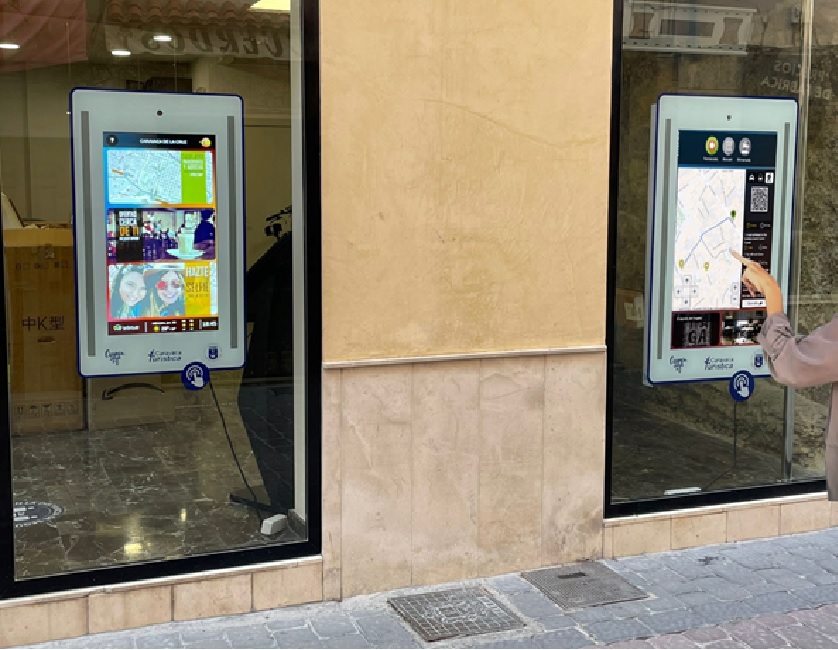
4. Caravaca de la Cruz (Murcia). Office open 24 hours a day and automatic content updating.
This project has three objectives.
1. To interact with tourists before, during and after their visit to the town. To this end, there is a proposal to integrate content with all the tourist’s points of contact in order to get the tourist’s data and improve their familiarity with the town in three ways:
i. Before. Via the website http://www.turismocaravaca.com/es/ and from the Region of Murcia website https://www.murciaturistica.es/es/caravaca_de_la_cruz/, responding to tourists’ requests and helping them plan their trip.
Ii. During the trip. In the tourist information centres, helping advisers personalise the tourist experience in the destination via digital formats so that they can take it with them on their mobile phones with a QR code.
iii. After. By means of 24/7 interactive media that provide visual support and collect data from tourists.
2. Lighten the load on advisers by automating content updates, which is all integrated into the same platform, which means they don’t have to deal with uploading of content on different devices.
3. Collect information from the traveller at every contact with the destination described above, either before their arrival, at the information centre or post-trip in order to adapt Caravaca’s value proposition, and integrate this data with the Region of Murcia (ITREM).
Digitalisation
1. Tourist Information Point (TIP): Since it has limited opening hours, the aim is to provide information when the point is closed and, since it is small, to have a compact device that helps staff to manage the queue.
. 43” interactive window display: 1 touchscreen device located on the inside face of the exterior window of the TIP premises, providing interactivity yet preventing vandalism, since the display is mounted inside.
. 1 interactive 3” tactile kiosk inside the building, to help visitors visualise their experience before choosing the best option and saving it to their mobile phone.
. 1 46” video wall with 2×2 screens Behind the counter to highlight the most interesting content and run promotional campaigns depending on the season to promote lesser-known attractions.
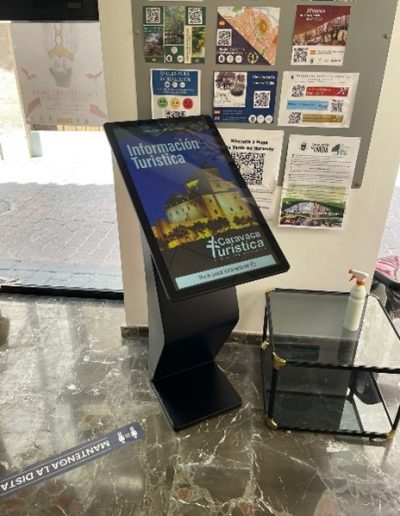
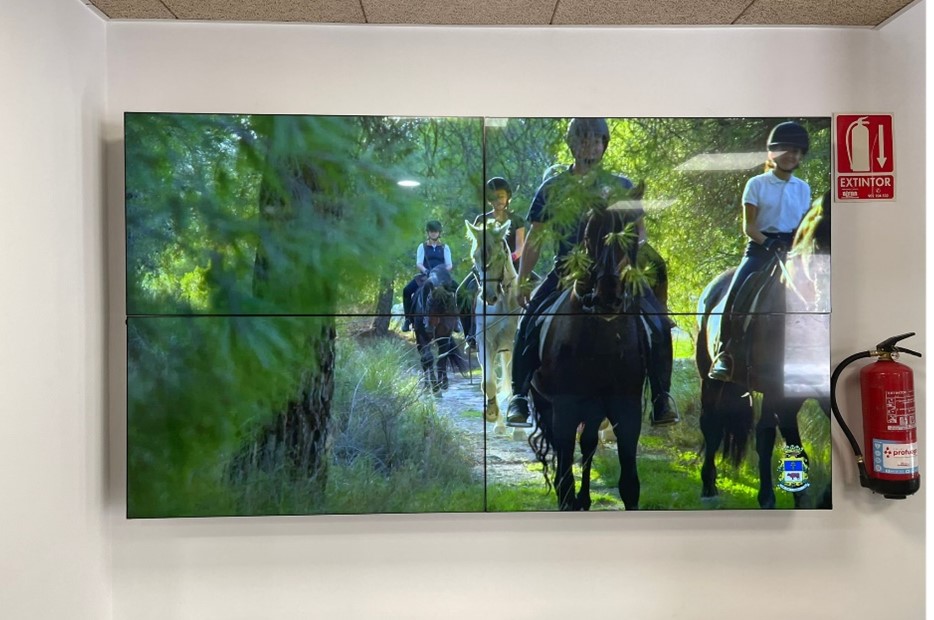
3. Outdoor equipment With a 49” interactive digital totem (en Plaza del Arco). And a smaller, cost-effective 32″ outdoor pedestal stand.

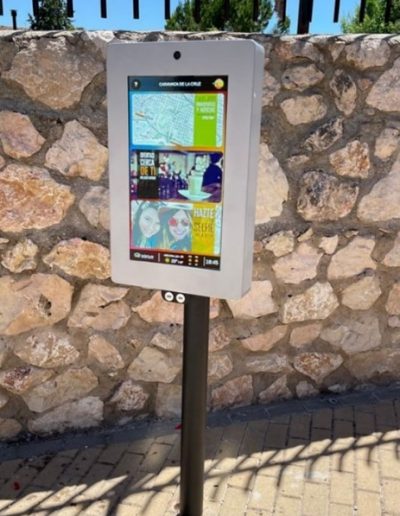
What’s missing:
. Better accessibility.
. Provide information digitally and not on paper, since it forces them to register all requests on the platform again after providing information to the tourist.
. Use the same system that’s used on the website and information centres to personalise the route on social media.
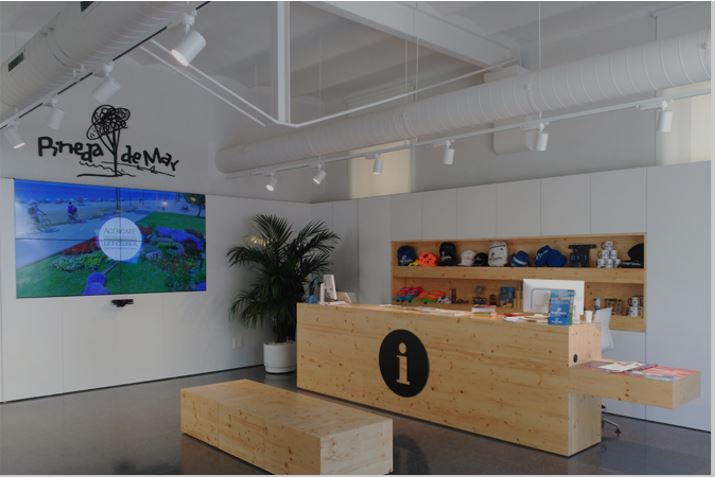
5. Pineda de Mar (Barcelona). Games for the family tourist
Pineda was one of the first tourist centres to go digital, back in 2017, and for that reason it deserves to be in this list. In Pineda the tourist is clearly a family holidaymaker, so they redesigned a 225 m2 room to turn it into more of an entertainment space.
The new Pineda Tourist Information Centre has a “video wall of thoughts”: a large screen equipped with a Kinect camera that detects visitors’ images and movements and makes them see speech bubbles with messages about everything that Pineda has to offer. By raising a hand, the visitor can change the language in which these thoughts are displayed, choosing from Catalan, Spanish, English and French.
The visitor will also find an information and consultation kiosk that offers a calendar of events, places of interest and outstanding services, as well as an interactive table for children so that they can paint while parents are getting information.
What’s missing:
. Paper-based information and registration.
. The “video wall of thoughts” provides a nice “wow” effect, but we’d like to see a presentation from an adviser using images relevant to the tourist’s stay as support.
. Personalise the displays according to the traveller and collect their data in a CRM to turn them into return visitors.
6. Short checklist for digitalising your tourist information centre
Like a traffic light (green, yellow and red), this checklist will help you to determine your level of digitisation. 10 points to pass!
Before (attracting visitors from the website and social media)
. Content by type of traveller (buyer persona) on the website.
. Downloadables (guides, agendas) in exchange for the tourist’s email.
. Forms and the opportunity to engage in conversation on the website, social media.
During (make an impact at the information centre)
. Using the advisers’ expertise, create predefined routes that can be sent to the tourists’ phone once they’re at the destination.
. Select videos and resources based on the story the adviser wants to tell.
. Use monitors and tablets to make a visual impact while explaining the different attractions.
. Be able to give info 24/7 with QR, screens when the centre is closed or in prime areas such as squares and avenues.
After (build loyalty)
. Digital survey for automated reporting
. Use a website in the tourist centre and a public website to track what tourists are asking for.
. Target tourists and interests with segmented campaigns.
I hope these tips will help you to digitalise your centre and come up with a checklist of things you can improve. Here’s a link to our Cicerone solution, designed to cover the digitalisation of tourist information centres.
Subscribe to our newsletter
And keep up with all our latest news!

